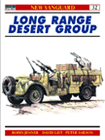 Jenner and List's book is a perfect starting
point for research into LRDG's history. It offers a concise overview of
the Group's tactics, detailed descriptions of various pieces of equipment,
short bios of important people in LRDG history and a chronological overview
of missions. However, as with any Osprey publication, the real value of
this volume lies in the high-quality, full-color illustrations of vehicles
and the wealth of photographs of almost every vehicle ever used by LRDG,
making it an indispensable resource especially for modellers. (Note: Over
the years, there have been various editions of this title under different
labels; the only difference I am aware of is that the most recent one has
a 2-page cutaway drawing of a Chevy 30cwt which was lacking in earlier
editions).
Jenner and List's book is a perfect starting
point for research into LRDG's history. It offers a concise overview of
the Group's tactics, detailed descriptions of various pieces of equipment,
short bios of important people in LRDG history and a chronological overview
of missions. However, as with any Osprey publication, the real value of
this volume lies in the high-quality, full-color illustrations of vehicles
and the wealth of photographs of almost every vehicle ever used by LRDG,
making it an indispensable resource especially for modellers. (Note: Over
the years, there have been various editions of this title under different
labels; the only difference I am aware of is that the most recent one has
a 2-page cutaway drawing of a Chevy 30cwt which was lacking in earlier
editions). |
 William Shaw's account of his term of service
as intelligence officer with the LRDG, written in 1943, stands out as
one of the most interesting accounts of the North African campaign. Shaw
paints a vivid picture of the Group's everyday life, relating hundreds
of small asides and anecdotes without ever losing track of the main narrative:
the story of a group of specialists deep in enemy territory, written by
someone who was there. A must-read.
William Shaw's account of his term of service
as intelligence officer with the LRDG, written in 1943, stands out as
one of the most interesting accounts of the North African campaign. Shaw
paints a vivid picture of the Group's everyday life, relating hundreds
of small asides and anecdotes without ever losing track of the main narrative:
the story of a group of specialists deep in enemy territory, written by
someone who was there. A must-read. |
 Owen, himself one of the founding members
of LRDG, relates his memories of the desert campaign in a very personal
way, focussing more on the people he lived and fought with than on the
historical context. His book has the additional merit of being (to my
knowledge) the only eyewitness account of LRDG missions in the Mediterranean
after the end of the African campaign.
Owen, himself one of the founding members
of LRDG, relates his memories of the desert campaign in a very personal
way, focussing more on the people he lived and fought with than on the
historical context. His book has the additional merit of being (to my
knowledge) the only eyewitness account of LRDG missions in the Mediterranean
after the end of the African campaign. |
 Alaistair Timpson took command of G Patrol
in 1941, taking over from Michael Crichton Stuart. Although it must be said
that Timpson's commanding skills were obviously much better than his writing
talents (his excursions into regimental history, among other things, can
get a bit tedious in places), his book covers in great detail all the G
Patrol missions that were carried out in Africa and gives very interesting
character profiles of many Patrol members. Not necessarily the ideal choice
for a relaxed evening on the couch, but an indispensable resource for serious
historical research.
Alaistair Timpson took command of G Patrol
in 1941, taking over from Michael Crichton Stuart. Although it must be said
that Timpson's commanding skills were obviously much better than his writing
talents (his excursions into regimental history, among other things, can
get a bit tedious in places), his book covers in great detail all the G
Patrol missions that were carried out in Africa and gives very interesting
character profiles of many Patrol members. Not necessarily the ideal choice
for a relaxed evening on the couch, but an indispensable resource for serious
historical research. |
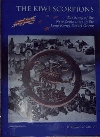 This volume by New Zealand LRDG enthusiast
Brendan O'Carroll is highly recommended to anyone with an interest in the
story of LRDG. O'Carroll located many surviving LRDG members in New Zealand,
interviewed them and collected about 250 photos, most of which have never
been published before. The result is nothing short of astonishing: a massive
volume with detailed, hands-on descriptions of the Group's everyday life,
a history of all the Group's missions with many interesting sidenotes, and
detailed descriptions of equipment and vehicles used (including some vehicles
I never knew were employed by LRDG). The book is a bit difficult to get
(at least here in Germany) and carries a hefty price tag of about 40 US$,
but it is definitely worth every cent of it.
This volume by New Zealand LRDG enthusiast
Brendan O'Carroll is highly recommended to anyone with an interest in the
story of LRDG. O'Carroll located many surviving LRDG members in New Zealand,
interviewed them and collected about 250 photos, most of which have never
been published before. The result is nothing short of astonishing: a massive
volume with detailed, hands-on descriptions of the Group's everyday life,
a history of all the Group's missions with many interesting sidenotes, and
detailed descriptions of equipment and vehicles used (including some vehicles
I never knew were employed by LRDG). The book is a bit difficult to get
(at least here in Germany) and carries a hefty price tag of about 40 US$,
but it is definitely worth every cent of it. The book can be ordered from Jack Valenti of the LRDG Preservation Society for 40$ plus postage. |
 This recently-published book by the son of
SAS veteran Jack Morgan gives a complete history of the LRDG from its beginnings
to the unit's disbandment in 1945 in a most unusual way: the main source
for Morgan's narrative are contributions to the annual newsletter of the
LRDG Association (founded by LRDG members after the end of the war to keep
in touch with each other), often quoted verbatim. To fully understand the
significance of all these old soldiers' stories, it is quite necessary to
already know a bit about LRDG history. Thus, Morgan's book might not be
the best starting point for reading up on LRDG; however, after one has read
several other books on the subject, the collection of funny anecdotes and
interesting observations delivered by LRDG veterans is most highly enjoyable.
This recently-published book by the son of
SAS veteran Jack Morgan gives a complete history of the LRDG from its beginnings
to the unit's disbandment in 1945 in a most unusual way: the main source
for Morgan's narrative are contributions to the annual newsletter of the
LRDG Association (founded by LRDG members after the end of the war to keep
in touch with each other), often quoted verbatim. To fully understand the
significance of all these old soldiers' stories, it is quite necessary to
already know a bit about LRDG history. Thus, Morgan's book might not be
the best starting point for reading up on LRDG; however, after one has read
several other books on the subject, the collection of funny anecdotes and
interesting observations delivered by LRDG veterans is most highly enjoyable.Jack Valenti just informed me that he has a number of these books in store; if you're living in the States, you can order it from him for $32.95 plus postage. |
 Irving's classic account of the life of
Afrika Korps' famous General draws an interesting portrait of one of the
most prolific figures of World War 2: a brilliant tactician and inspiring
leader, often forced to improvise and often successfull against horrible
odds, but also a devout follower of the Führer, unable or unwilling
to see the dark side of the Reich's politics, Rommel frequently quarreled
with the more conservative members of the General Staff. Both Rommel's stunning
successes and glaring failures are analyzed in great detail, showing how
the desert fox frequently operated on sheer luck, ignoring all traditional
military logic. Irving went to great lengths to locate source material and
interview surviving eyewitnesses of Rommel's life, giving the whole book
a very dynamic and direct atmosphere, a feeling of really getting to know
the man behind Germany's African adventure.
Irving's classic account of the life of
Afrika Korps' famous General draws an interesting portrait of one of the
most prolific figures of World War 2: a brilliant tactician and inspiring
leader, often forced to improvise and often successfull against horrible
odds, but also a devout follower of the Führer, unable or unwilling
to see the dark side of the Reich's politics, Rommel frequently quarreled
with the more conservative members of the General Staff. Both Rommel's stunning
successes and glaring failures are analyzed in great detail, showing how
the desert fox frequently operated on sheer luck, ignoring all traditional
military logic. Irving went to great lengths to locate source material and
interview surviving eyewitnesses of Rommel's life, giving the whole book
a very dynamic and direct atmosphere, a feeling of really getting to know
the man behind Germany's African adventure. Description coming soon
Description coming soon It seems curious that so many of the special forces
that operated behind enemy lines during World War 2 were part of the British
Army. Thompson seeks to answer the question whether there is something about
the British character that made special forces such an important part of the
British war effort. During his inquiry, he gives detailed histories of forces
such as LRDG, the SAS, the Chindits and various other groups - on his way,
he often gives interesting comparisons between these groups and comes to
a number of fascinating conclusions about a peculiar way of fighting a war
without actually fighting.
It seems curious that so many of the special forces
that operated behind enemy lines during World War 2 were part of the British
Army. Thompson seeks to answer the question whether there is something about
the British character that made special forces such an important part of the
British war effort. During his inquiry, he gives detailed histories of forces
such as LRDG, the SAS, the Chindits and various other groups - on his way,
he often gives interesting comparisons between these groups and comes to
a number of fascinating conclusions about a peculiar way of fighting a war
without actually fighting. description coming soon
description coming soon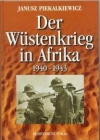 Although I usually only recommend books
available in English, I had to make an exception for Piekalkiewicz's excellent
overview of the African war: lavishly illustrated with hundreds of pictures,
the book offers a day-to-day overview of the complete campaign, qouting
sources such as newspapers, letters and diaries to give a good hands-on
impression of the events. Piekalkiewicz also includes evaluations of all
major battles, background information on political events of the time and
a brief description of the Northern African landscape. If you are able
to read German, I highly recommend you pick up this book.
Although I usually only recommend books
available in English, I had to make an exception for Piekalkiewicz's excellent
overview of the African war: lavishly illustrated with hundreds of pictures,
the book offers a day-to-day overview of the complete campaign, qouting
sources such as newspapers, letters and diaries to give a good hands-on
impression of the events. Piekalkiewicz also includes evaluations of all
major battles, background information on political events of the time and
a brief description of the Northern African landscape. If you are able
to read German, I highly recommend you pick up this book. One of the true classics on 20th century
history, Shirer's extremely well-researched analysis of the history of Nazi
Germany is a must-read for everyone interested in World War 2 and the events
that led up to the war. As a journalist in Berlin in the 1930's and a good
part of the 1940's, Shirer was an eyewitness to many of the events that shaped
the Third Reich and finally toppled all of Europe into a devastating war.
After the war ended, Shirer went to great lengths to search through the piles
of archived material to reconstruct the story of Hitler's Empire. The National
Socialist ideology is analyzed in great detail, along with the unspeakable
horrors this ideology's perpetrators unleashed not only on Jews, but also
on communists, inhabitants of occupied territories and basically anyone else
who stood in their way. Shirer also shows how again and again individuals
and organisations who would have had the power to stop Hitler's rise to power
or avert Germany's being turned into a dictatorship (from the German trade
unions to Chamberlain) stood idly by and let Hitler have his way, too caught
up in their own schemes to realize what was happening. A thought-provoking
read.
One of the true classics on 20th century
history, Shirer's extremely well-researched analysis of the history of Nazi
Germany is a must-read for everyone interested in World War 2 and the events
that led up to the war. As a journalist in Berlin in the 1930's and a good
part of the 1940's, Shirer was an eyewitness to many of the events that shaped
the Third Reich and finally toppled all of Europe into a devastating war.
After the war ended, Shirer went to great lengths to search through the piles
of archived material to reconstruct the story of Hitler's Empire. The National
Socialist ideology is analyzed in great detail, along with the unspeakable
horrors this ideology's perpetrators unleashed not only on Jews, but also
on communists, inhabitants of occupied territories and basically anyone else
who stood in their way. Shirer also shows how again and again individuals
and organisations who would have had the power to stop Hitler's rise to power
or avert Germany's being turned into a dictatorship (from the German trade
unions to Chamberlain) stood idly by and let Hitler have his way, too caught
up in their own schemes to realize what was happening. A thought-provoking
read. 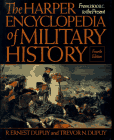 A veritable tome of information about virtually
anything related to military history, the Harper Encyclopedia is an excellent
reference work with detailed descriptions of campaigns (complete with
maps for every major battle), evaluations of military leaders, tactics
and equipment as well as basic information on the political backgrounds
of military conflicts. Of course, due to the vast amount of wars and conflicts
covered, single chapters do not provide exhaustive information on every
detail (the whole North African Campaign, for example, is covered in about
four pages); however, the Encyclopedia serves as an indispensable resource
for quick and accurate information and has a well-earned place in my reference
bookshelf.
A veritable tome of information about virtually
anything related to military history, the Harper Encyclopedia is an excellent
reference work with detailed descriptions of campaigns (complete with
maps for every major battle), evaluations of military leaders, tactics
and equipment as well as basic information on the political backgrounds
of military conflicts. Of course, due to the vast amount of wars and conflicts
covered, single chapters do not provide exhaustive information on every
detail (the whole North African Campaign, for example, is covered in about
four pages); however, the Encyclopedia serves as an indispensable resource
for quick and accurate information and has a well-earned place in my reference
bookshelf.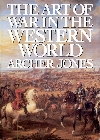 Archer Jones' comprehensive overview of
the operational aspects of land warfare should be required reading for
everyone interested in the historical development of strategy, tactics
and logistics; his analysis of concepts like interior vs. exterior lines
of communication, effective combined-arms approaches and the countering
relationships between different weapons systems is vividly illustrated
with a wealth of historical examples, showing how again and again military
doctrines could be extremely successfull until they were challenged by
superior doctrines that were to change the way battles were fought. Jones
also takes into account the constant influence of new technological advances
on tactical considerations and manages to develop a theory of combined
arms that spans from bronze-age chariot warfare over the medieval struggles
between heavy infantry and cavalry to the relatively recent additions of
air forces, tank armies and long range misslies. Reading this book really
helps one understand what happened in wars over the centuries and why.
Archer Jones' comprehensive overview of
the operational aspects of land warfare should be required reading for
everyone interested in the historical development of strategy, tactics
and logistics; his analysis of concepts like interior vs. exterior lines
of communication, effective combined-arms approaches and the countering
relationships between different weapons systems is vividly illustrated
with a wealth of historical examples, showing how again and again military
doctrines could be extremely successfull until they were challenged by
superior doctrines that were to change the way battles were fought. Jones
also takes into account the constant influence of new technological advances
on tactical considerations and manages to develop a theory of combined
arms that spans from bronze-age chariot warfare over the medieval struggles
between heavy infantry and cavalry to the relatively recent additions of
air forces, tank armies and long range misslies. Reading this book really
helps one understand what happened in wars over the centuries and why. I regard anything written by John Keegan
as an immediate must-read; among his numerous publications, the History
of Warfare stands out as one of the finest overviews of military history
available: written in an easy-to-read narrative tone, this work follows
the evolution of warfare from the beginnings of large-scale conflicts in
the bronze age right through to the nuclear stalemate of recent days, on
its way detailing developments such as the Greek Phalanx, the Mongols' tactical
inventions and the intricacies of submarine warfare in WW2. Keegan offers
a wealth of interesting insights and brilliant interpretations; his evaluation
of the "decisive battle" evolving in ancient Greece out of the necessities
of an agricultural society is easily one of the best accounts of warfare
in antiquity I have ever read. Even though Keegan sometimes goes a bit overboard
in ascribing central importance to relatively minor details (and presupposes
quite some knowledge of the general historical background), everyone interested
in military developments will gain lots of valuable insight from this volume.
I regard anything written by John Keegan
as an immediate must-read; among his numerous publications, the History
of Warfare stands out as one of the finest overviews of military history
available: written in an easy-to-read narrative tone, this work follows
the evolution of warfare from the beginnings of large-scale conflicts in
the bronze age right through to the nuclear stalemate of recent days, on
its way detailing developments such as the Greek Phalanx, the Mongols' tactical
inventions and the intricacies of submarine warfare in WW2. Keegan offers
a wealth of interesting insights and brilliant interpretations; his evaluation
of the "decisive battle" evolving in ancient Greece out of the necessities
of an agricultural society is easily one of the best accounts of warfare
in antiquity I have ever read. Even though Keegan sometimes goes a bit overboard
in ascribing central importance to relatively minor details (and presupposes
quite some knowledge of the general historical background), everyone interested
in military developments will gain lots of valuable insight from this volume.